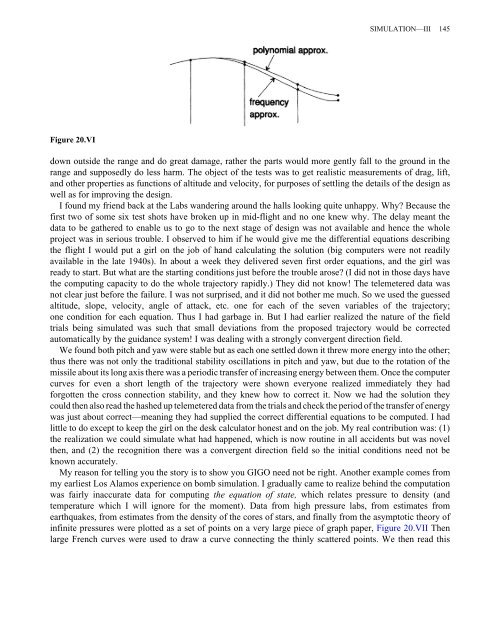hamming
hamming
hamming
Create successful ePaper yourself
Turn your PDF publications into a flip-book with our unique Google optimized e-Paper software.
SIMULATION—III 145Figure 20.VIdown outside the range and do great damage, rather the parts would more gently fall to the ground in therange and supposedly do less harm. The object of the tests was to get realistic measurements of drag, lift,and other properties as functions of altitude and velocity, for purposes of settling the details of the design aswell as for improving the design.I found my friend back at the Labs wandering around the halls looking quite unhappy. Why? Because thefirst two of some six test shots have broken up in mid-flight and no one knew why. The delay meant thedata to be gathered to enable us to go to the next stage of design was not available and hence the wholeproject was in serious trouble. I observed to him if he would give me the differential equations describingthe flight I would put a girl on the job of hand calculating the solution (big computers were not readilyavailable in the late 1940s). In about a week they delivered seven first order equations, and the girl wasready to start. But what are the starting conditions just before the trouble arose? (I did not in those days havethe computing capacity to do the whole trajectory rapidly.) They did not know! The telemetered data wasnot clear just before the failure. I was not surprised, and it did not bother me much. So we used the guessedaltitude, slope, velocity, angle of attack, etc. one for each of the seven variables of the trajectory;one condition for each equation. Thus I had garbage in. But I had earlier realized the nature of the fieldtrials being simulated was such that small deviations from the proposed trajectory would be correctedautomatically by the guidance system! I was dealing with a strongly convergent direction field.We found both pitch and yaw were stable but as each one settled down it threw more energy into the other;thus there was not only the traditional stability oscillations in pitch and yaw, but due to the rotation of themissile about its long axis there was a periodic transfer of increasing energy between them. Once the computercurves for even a short length of the trajectory were shown everyone realized immediately they hadforgotten the cross connection stability, and they knew how to correct it. Now we had the solution theycould then also read the hashed up telemetered data from the trials and check the period of the transfer of energywas just about correct—meaning they had supplied the correct differential equations to be computed. I hadlittle to do except to keep the girl on the desk calculator honest and on the job. My real contribution was: (1)the realization we could simulate what had happened, which is now routine in all accidents but was novelthen, and (2) the recognition there was a convergent direction field so the initial conditions need not beknown accurately.My reason for telling you the story is to show you GIGO need not be right. Another example comes frommy earliest Los Alamos experience on bomb simulation. I gradually came to realize behind the computationwas fairly inaccurate data for computing the equation of state, which relates pressure to density (andtemperature which I will ignore for the moment). Data from high pressure labs, from estimates fromearthquakes, from estimates from the density of the cores of stars, and finally from the asymptotic theory ofinfinite pressures were plotted as a set of points on a very large piece of graph paper, Figure 20.VII Thenlarge French curves were used to draw a curve connecting the thinly scattered points. We then read this


